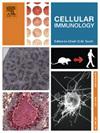炎性疾病中的NLRP3炎性小体:细胞动力学及其在肉芽肿形成中的作用
IF 2.9
4区 医学
Q2 CELL BIOLOGY
引用次数: 0
摘要
先天免疫系统通过模式识别受体(PRRs)识别病原体相关分子模式(PAMPs)和损伤相关分子模式(DAMPs)。炎性小体,细胞质蛋白复合物,在PAMPs和DAMPs的响应下被激活,导致炎症细胞因子如IL-1β和IL-18的释放。NLRP3炎性小体是最具特征的炎性小体之一,最近它的激活与肉芽肿的形成有关,肉芽肿是免疫细胞聚集以应对感染的结构,如由细菌、真菌和寄生虫引起的感染,以及自身炎症性疾病,如结节病。巨噬细胞中NLRP3炎性小体的激活诱导细胞因子的释放,这些细胞因子将免疫细胞(如单核细胞和淋巴细胞)招募到感染部位。中性粒细胞、单核细胞、T淋巴细胞和B淋巴细胞在肉芽肿的形成和维持中起重要作用。尽管NLRP3在免疫应答、细胞募集和肉芽肿形成中起着关键作用,但其在不同细胞类型中的许多功能仍有待阐明。在这篇综述中,我们的目标是概述NLRP3炎性小体不仅是一种蛋白质复合物,帮助先天免疫细胞对抗细胞内病原体,而且在协调免疫反应方面具有更广泛的意义。NLRP3炎症小体的这一未被充分探索的方面为其参与免疫提供了一个新的视角。因此,我们对NLRP3炎性小体在免疫细胞浸润中的作用及其在炎症性疾病肉芽肿组织形成中的意义进行综述。本文章由计算机程序翻译,如有差异,请以英文原文为准。
The NLRP3 Inflammasome in inflammatory diseases: Cellular dynamics and role in granuloma formation
The innate immune system recognizes pathogen-associated molecular patterns (PAMPs) and damage associated molecular patterns (DAMPs) through pattern recognition receptors (PRRs). Inflammasomes, cytoplasmic protein complexes, are activated in response to PAMPs and DAMPs, leading to the release of inflammatory cytokines such as IL-1β and IL-18. NLRP3 inflammasome is one of the best characterized inflammasomes and recently its activation has been associated with granuloma formation, structures that aggregate immune cells in response to infections, such as those caused by bacteria, fungi and parasites, and autoinflammatory diseases, such as sarcoidosis. Activation of NLRP3 inflammasomes in macrophages induces the release of cytokines that recruit immune cells, such as monocytes and lymphocytes, to the site of infection. Neutrophils, monocytes, T and B lymphocytes are important in the formation and maintenance of granulomas. Although NLRP3 plays a key role in the immune response, cell recruitment and granuloma formation, many aspects of its function in different cell types remain to be elucidated. In this review, we aim to outline the NLRP3 inflammasome not only as a protein complex that aids innate immune cells in combating intracellular pathogens but also as a platform with broader implications in orchestrating immune responses. This underexplored aspect of the NLRP3 inflammasome presents a novel perspective on its involvement in immunity. Thus, we review the current understanding of the role of the NLRP3 inflammasome in immune cell infiltration and its significance in the organization and formation of granulomas in inflammatory diseases.
求助全文
通过发布文献求助,成功后即可免费获取论文全文。
去求助
来源期刊

Cellular immunology
生物-免疫学
CiteScore
8.20
自引率
2.30%
发文量
102
审稿时长
30 days
期刊介绍:
Cellular Immunology publishes original investigations concerned with the immunological activities of cells in experimental or clinical situations. The scope of the journal encompasses the broad area of in vitro and in vivo studies of cellular immune responses. Purely clinical descriptive studies are not considered.
Research Areas include:
• Antigen receptor sites
• Autoimmunity
• Delayed-type hypersensitivity or cellular immunity
• Immunologic deficiency states and their reconstitution
• Immunologic surveillance and tumor immunity
• Immunomodulation
• Immunotherapy
• Lymphokines and cytokines
• Nonantibody immunity
• Parasite immunology
• Resistance to intracellular microbial and viral infection
• Thymus and lymphocyte immunobiology
• Transplantation immunology
• Tumor immunity.
 求助内容:
求助内容: 应助结果提醒方式:
应助结果提醒方式:


